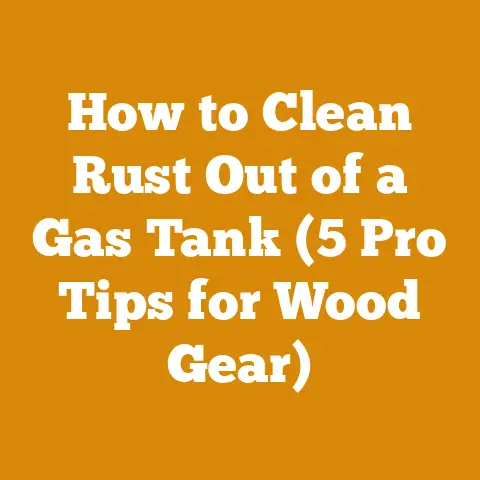Stihl Chainsaw 011 AV Buying Guide (5 Pro Tips for Woodcutters)
Every year, improperly maintained chainsaws contribute to thousands of injuries, many of which could be prevented with proper knowledge and care. That’s why I’ve dedicated countless hours to understanding chainsaws inside and out, particularly the Stihl 011 AV, a reliable workhorse for many. In this guide, I’ll share five pro tips, learned from years of experience, to help you buy and maintain a Stihl 011 AV chainsaw, ensuring it remains a valuable tool for years to come.
Stihl Chainsaw 011 AV Buying Guide: 5 Pro Tips for Woodcutters
The Stihl 011 AV is a classic chainsaw, known for its reliability and ease of use. While it’s no longer in production, many are still in circulation, often available used at reasonable prices. Whether you’re a seasoned woodcutter or just starting out, understanding the ins and outs of this model is crucial for safe and efficient wood processing. This guide will cover essential aspects, from assessing a used model to performing basic maintenance.
Understanding the Stihl 011 AV
The Stihl 011 AV is a lightweight chainsaw designed for smaller tasks, such as limbing, pruning, and cutting small-diameter firewood. It typically features a 12-16 inch bar, making it manageable for beginners and ideal for tight spaces.
-
Key Specs:
- Engine Displacement: Around 30cc
- Weight: Approximately 10 lbs (without bar and chain)
- Bar Length: Typically 12-16 inches
- Fuel Mix Ratio: 50:1 (gasoline to two-stroke oil)
- AV stands for Anti-Vibration, indicating that the saw is equipped with a system to reduce operator fatigue.
-
Why Choose a Stihl 011 AV?
- Lightweight and Maneuverable: Easier to handle than larger chainsaws, reducing fatigue during extended use.
- Reliable: Stihl is known for its durable construction and reliable engines.
- Affordable (Used): Can be found at reasonable prices on the used market.
- Easy to Maintain: Simple design makes it relatively easy to perform basic maintenance.
Pro Tip #1: Inspecting a Used Stihl 011 AV – A Checklist for Quality
Buying a used chainsaw can be a gamble, but with a thorough inspection, you can minimize the risk. I’ve seen too many people get burned by hidden problems, so I always follow a rigorous checklist.
-
Visual Inspection:
- Casing: Check for cracks, breaks, or signs of excessive wear. Pay close attention to areas around the handle and engine mounts.
- Bar and Chain: Look for a straight bar with minimal wear. The chain should be sharp and properly tensioned. Check the depth gauges (rakers) to ensure they are at the correct height.
- Fuel and Oil Tanks: Inspect for leaks or damage. Check the fuel and oil lines for cracks or brittleness.
- Air Filter: Remove the air filter cover and inspect the filter. A dirty or damaged filter can restrict airflow and affect engine performance.
- Spark Plug: Remove the spark plug and examine its condition. A fouled or worn spark plug can cause starting problems or poor performance. The color of the spark plug can also indicate engine health (tan is good, black is rich, white is lean).
-
Mechanical Inspection:
- Compression Test: This is the most crucial test. Use a compression tester to measure the engine’s compression. A healthy Stihl 011 AV should have a compression reading of at least 120 PSI. Anything lower indicates potential engine problems.
- How to Perform a Compression Test: Remove the spark plug, insert the compression tester into the spark plug hole, and pull the starter cord several times until the gauge reaches its maximum reading.
- Starter Mechanism: Check the starter cord for wear and tear. Pull the cord several times to ensure it retracts smoothly.
- Chain Brake: Engage and disengage the chain brake to ensure it functions properly. The chain brake should stop the chain immediately when engaged.
- Throttle and Choke: Test the throttle and choke levers to ensure they move freely and return to their original positions.
- Oil Pump: Check the oil pump by running the chainsaw briefly and observing whether oil is being dispensed onto the bar and chain.
- Compression Test: This is the most crucial test. Use a compression tester to measure the engine’s compression. A healthy Stihl 011 AV should have a compression reading of at least 120 PSI. Anything lower indicates potential engine problems.
-
Starting and Running:
- Cold Start: Observe how easily the chainsaw starts when cold. It should start within a few pulls.
- Idle: Once started, the chainsaw should idle smoothly without stalling.
- Throttle Response: Check the throttle response by quickly accelerating and decelerating the engine. It should respond quickly and smoothly.
- Smoke: Observe the color of the exhaust smoke. Excessive blue smoke indicates burning oil, which could be a sign of worn piston rings or valve seals.
- Unusual Noises: Listen for any unusual noises, such as knocking, rattling, or hissing. These noises could indicate internal engine problems.
-
Case Study: I once inspected a Stihl 011 AV that looked great on the outside, but the compression test revealed only 90 PSI. The seller claimed it ran fine, but the low compression meant it would likely require a costly engine rebuild soon. I walked away from that deal.
Pro Tip #2: Mastering the Fuel Mix – The Lifeblood of Your 011 AV
The Stihl 011 AV, like most two-stroke engines, relies on a precise mixture of gasoline and two-stroke oil for lubrication. Getting this wrong can lead to engine damage and reduced performance. I’ve seen countless engines ruined by incorrect fuel mixtures.
-
The Correct Ratio: 50:1
- This means 50 parts gasoline to 1 part two-stroke oil. Use high-quality two-stroke oil specifically designed for air-cooled engines. Stihl Ultra HP oil is a good choice.
- Why 50:1? This ratio provides adequate lubrication for the engine’s moving parts without causing excessive carbon buildup.
-
Mixing Fuel Properly:
- Use a Clean Container: Always use a clean, approved fuel container.
- Start with Oil: Pour the correct amount of two-stroke oil into the container first.
- Add Gasoline: Then, add the gasoline. Use fresh, high-octane gasoline (87 octane or higher).
- Mix Thoroughly: Shake the container vigorously to ensure the oil and gasoline are thoroughly mixed.
- Avoid Mixing Too Much: Only mix enough fuel for a few weeks. Gasoline can degrade over time, especially when mixed with oil.
-
The Dangers of Incorrect Fuel Mixes:
- Too Little Oil (Lean Mix): This can lead to insufficient lubrication, causing engine seizure and permanent damage.
- Too Much Oil (Rich Mix): This can cause excessive carbon buildup, fouled spark plugs, and reduced engine performance.
-
Ethanol Considerations:
- Ethanol-blended gasoline can be problematic for small engines like the Stihl 011 AV. Ethanol can absorb water, leading to corrosion and fuel system problems.
- Recommendation: Use ethanol-free gasoline whenever possible. If ethanol-blended gasoline is unavoidable, use a fuel stabilizer to help prevent water absorption and fuel degradation.
-
My Personal Experience: I once used a slightly richer fuel mix (40:1) in my Stihl 011 AV while cutting some particularly dense hardwood. While it seemed to run fine initially, I noticed excessive smoke and carbon buildup on the spark plug after a few hours of use. I switched back to the 50:1 ratio and the problem resolved itself.
Pro Tip #3: Chain Sharpening and Maintenance – Keeping Your Edge
A sharp chain is essential for safe and efficient cutting. A dull chain requires more force, increases the risk of kickback, and puts unnecessary strain on the engine. I’ve seen firsthand how a properly sharpened chain can transform a chainsaw’s performance.
-
Understanding Chain Anatomy:
- Cutters: The teeth that do the actual cutting.
- Depth Gauges (Rakers): Control the depth of the cut.
- Tie Straps: Connect the cutters and depth gauges.
- Drive Links: Fit into the bar groove and drive the chain around the bar.
-
Sharpening Techniques:
- Hand Sharpening:
- Tools: Round file (typically 5/32 inch for Stihl 011 AV), file guide, flat file, depth gauge tool.
- Procedure:
- Secure the chainsaw bar in a vise.
- Use the file guide to maintain the correct angle (typically 30 degrees) and depth.
- File each cutter consistently, using smooth, even strokes.
- Use the flat file and depth gauge tool to adjust the depth gauges (rakers) as needed.
- Using a Chainsaw Sharpener (Electric or Manual):
- Benefits: More precise and consistent sharpening.
- Procedure: Follow the manufacturer’s instructions for your specific sharpener.
- Hand Sharpening:
-
Maintaining Depth Gauges (Rakers):
- Importance: Depth gauges control the amount of wood each cutter takes. If they are too high, the chain will cut slowly. If they are too low, the chain will grab and cause kickback.
- Procedure: Use a flat file and depth gauge tool to maintain the correct depth. Consult your chainsaw’s manual for the recommended depth gauge setting.
-
Chain Tensioning:
- Importance: Proper chain tension is crucial for safe and efficient cutting. A loose chain can derail, while a tight chain can cause excessive wear on the bar and chain.
- Procedure:
- Loosen the bar nuts.
- Use the chain tensioning screw to adjust the chain tension.
- The chain should be snug against the bar but still able to be pulled around by hand.
- Tighten the bar nuts securely.
-
Chain Lubrication:
- Importance: Chain oil lubricates the chain and bar, reducing friction and wear.
- Procedure:
- Fill the oil reservoir with high-quality bar and chain oil.
- Check the oil level regularly and refill as needed.
- Ensure the oiler is functioning properly by observing whether oil is being dispensed onto the bar and chain.
-
Case Study: I once worked with a logger who consistently neglected chain maintenance. His chains were always dull, and he frequently experienced kickback. After teaching him proper sharpening techniques and the importance of chain tensioning and lubrication, his cutting speed increased dramatically, and he experienced far fewer safety incidents.
Pro Tip #4: Carburetor Adjustment – Fine-Tuning for Peak Performance
The carburetor controls the air-fuel mixture entering the engine. Proper carburetor adjustment is essential for optimal performance, fuel efficiency, and engine longevity. I’ve spent hours tweaking carburetors to get the perfect balance.
-
Understanding Carburetor Components:
- Idle Speed Screw (LA): Controls the engine’s idle speed.
- Low-Speed Jet (L): Controls the air-fuel mixture at low speeds.
- High-Speed Jet (H): Controls the air-fuel mixture at high speeds.
-
Carburetor Adjustment Procedure:
- Warm Up the Engine: Start the chainsaw and let it warm up for a few minutes.
- Adjust the Idle Speed (LA): Turn the idle speed screw until the engine idles smoothly without stalling. The chain should not be moving at idle.
- Adjust the Low-Speed Jet (L):
- Turn the low-speed jet clockwise (lean) until the engine starts to stumble or hesitate.
- Then, turn the low-speed jet counterclockwise (rich) until the engine starts to smoke or run roughly.
- Find the sweet spot in between these two extremes where the engine runs smoothly and responds quickly to throttle inputs.
- Adjust the High-Speed Jet (H):
- Important: This adjustment should only be performed by experienced users. Running the engine too lean at high speeds can cause engine damage.
- Turn the high-speed jet clockwise (lean) until the engine starts to bog down or lose power.
- Then, turn the high-speed jet counterclockwise (rich) until the engine starts to smoke or run roughly.
- Find the sweet spot in between these two extremes where the engine runs smoothly and delivers maximum power.
- Fine-Tune: After making these adjustments, let the engine cool down and recheck the settings. Small adjustments may be necessary to achieve optimal performance.
-
Troubleshooting Carburetor Problems:
- Engine Won’t Start: Check the fuel supply, spark plug, and air filter. A clogged carburetor can also prevent the engine from starting.
- Engine Stalls at Idle: Adjust the idle speed screw. A lean low-speed mixture can also cause stalling.
- Engine Bogs Down Under Load: Adjust the high-speed jet. A lean high-speed mixture can cause bogging.
- Engine Smokes Excessively: A rich fuel mixture can cause excessive smoke.
-
Cleaning the Carburetor:
- Importance: A dirty or clogged carburetor can cause a variety of performance problems.
- Procedure:
- Remove the carburetor from the chainsaw.
- Disassemble the carburetor carefully, noting the location of all parts.
- Clean all parts with carburetor cleaner.
- Reassemble the carburetor, replacing any worn or damaged parts.
- Reinstall the carburetor on the chainsaw and adjust as needed.
-
Case Study: A friend of mine was complaining that his Stihl 011 AV was running poorly. He had replaced the spark plug and air filter, but the problem persisted. I checked the carburetor and found that it was clogged with debris. After cleaning the carburetor and adjusting the settings, the chainsaw ran like new.
Pro Tip #5: Safety First – Protecting Yourself and Others
Chainsaw operation is inherently dangerous. Always prioritize safety and follow all safety precautions. I’ve seen too many accidents caused by carelessness or lack of training.
-
Personal Protective Equipment (PPE):
- Eye Protection: Wear safety glasses or a face shield to protect your eyes from flying debris.
- Hearing Protection: Wear earplugs or earmuffs to protect your hearing from the chainsaw’s noise.
- Head Protection: Wear a hard hat to protect your head from falling branches or debris.
- Hand Protection: Wear chainsaw gloves to protect your hands from cuts and vibrations.
- Leg Protection: Wear chainsaw chaps or pants to protect your legs from accidental cuts.
- Foot Protection: Wear sturdy boots with good ankle support.
-
Safe Operating Practices:
- Read the Manual: Familiarize yourself with the chainsaw’s operating manual.
- Inspect the Chainsaw: Before each use, inspect the chainsaw for any damage or defects.
- Clear the Work Area: Remove any obstacles from the work area.
- Establish an Escape Route: Plan an escape route in case of kickback.
- Use Proper Cutting Techniques: Use proper cutting techniques to avoid kickback.
- Maintain a Firm Grip: Keep a firm grip on the chainsaw with both hands.
- Avoid Overreaching: Avoid overreaching or cutting above shoulder height.
- Never Cut with the Tip of the Bar: The tip of the bar is the most dangerous part of the chainsaw and is prone to kickback.
- Be Aware of Your Surroundings: Be aware of your surroundings and watch out for hazards such as power lines, fences, and people.
- Take Breaks: Take frequent breaks to avoid fatigue.
- Never Operate a Chainsaw Under the Influence of Drugs or Alcohol:
-
Understanding Kickback:
- What is Kickback? Kickback is a sudden, uncontrolled movement of the chainsaw bar back towards the operator.
- Causes of Kickback:
- Cutting with the tip of the bar.
- Pinching the bar in the cut.
- Hitting a foreign object with the bar.
- Preventing Kickback:
- Use a chainsaw with a chain brake and anti-kickback features.
- Use proper cutting techniques.
- Maintain a firm grip on the chainsaw.
- Be aware of your surroundings.
-
First Aid:
- Keep a well-stocked first aid kit on hand.
- Know how to treat cuts, burns, and other injuries.
- Seek medical attention immediately for serious injuries.
-
Case Study: I once witnessed a near-fatal chainsaw accident. A homeowner was cutting down a tree without wearing proper PPE. He lost control of the chainsaw and severely cut his leg. Fortunately, he was able to call for help and received prompt medical attention, but he was left with permanent scarring and limited mobility. This incident reinforced the importance of always prioritizing safety when operating a chainsaw.
Additional Considerations for the Stihl 011 AV
- Parts Availability: While the Stihl 011 AV is no longer in production, parts are still generally available through online retailers and some local chainsaw shops. However, availability may decrease over time, so it’s wise to stock up on essential parts like spark plugs, air filters, and fuel lines.
- Maintenance Schedule:
- Daily: Check the chain tension, oil level, and fuel level. Clean the air filter.
- Weekly: Sharpen the chain. Inspect the bar for wear. Grease the bar sprocket.
- Monthly: Clean the carburetor. Replace the spark plug. Inspect the fuel lines.
- Annually: Have the chainsaw professionally serviced.
- Storage: When storing the chainsaw for an extended period, drain the fuel tank and run the engine until it stalls to prevent fuel from gumming up the carburetor. Remove the chain and bar and clean them thoroughly. Store the chainsaw in a dry, safe place.
By following these pro tips, you can buy, maintain, and safely operate a Stihl 011 AV chainsaw, ensuring it remains a valuable tool for your wood processing needs. Remember, chainsaw safety is paramount. Always prioritize safety and follow all safety precautions. With proper care and maintenance, your Stihl 011 AV can provide years of reliable service.






